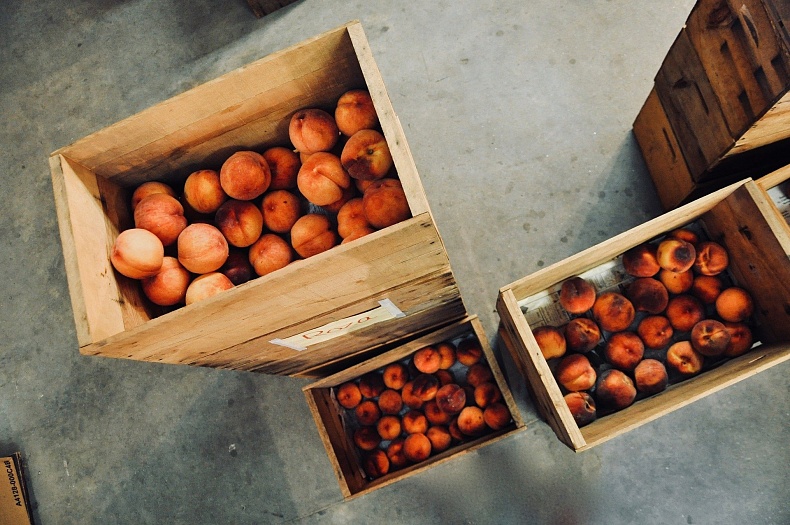Storing peaches
02.02.2022 | Peaches
Harvesting
Before harvesting, it is important to determine harvesting maturity correctly. One way is by the sugar content of the fruit, which ideally should be 11°Bx, although there are gradations by variety. There are instruments for determining maturity, such as an optical ripeness analyser or penetrometer. If the load is between 2.4 and 2.7, the peach is considered ripe.
The main prerequisite during harvesting is not to let the fruit stay in the sun. It is best not to let the harvested peaches stay in the orchard at all, even in the shade.
The ideal harvesting time is mid-August to early September. It's best to harvest in the morning, when temperatures are below 12 degrees. It is important not to harvest peaches when dew has settled on them.
Early- and medium-sized varieties are not very suitable for long-term storage. This is primarily due to the fact that they ripen in August and it is difficult to harvest them in cooler temperatures. Late varieties are better suited to long-term storage in this respect.
Larger varieties are more difficult to store because the fruit is more easily damaged during harvesting. Medium-sized varieties, weighing 180-200g, store better.
The best whole fruit are always the ones to be stored!
Harvest in different containers. Peaches do not like to be touched too much. Therefore, when removing the fruit from the tree, put your whole palm (not your fingers!) around it and twist it slightly to avoid damaging it. Pulling on the peach can result in the stalk and pulp being torn off.
Stacking in a crate: no more than 5 tiers, but ideally no more than 2 layers in 5-10 kg crates.
Cooling
The main aim of this step is to cool the pit (not the flesh!), which will stop the ripening of the fruit (anthogenesis).
A mobile chamber can be used for intensive cooling immediately in the field. This method is usually used for cooling before selling fresh, if long-term storage is not foreseen. In this case, the crop must also be transported in thermobooths.
If you do intend to send your crop for long-term storage, it is better to exclude the cooling stages in the field and transport in a thermobooth, as there is a huge risk of breaking the cold chain (e.g. when transferring the fruit from the machine to the storage facility). This will surely lead to the formation of condensation, which can spoil the entire crop.
The shorter the journey from the orchard to the storage room, the better.
Only by cooling in a gaseous environment can spoilage be reduced.
Before storing for a long period of time (if not in the controlled atmosphere), a culling operation must be made. For this purpose, peaches stand for a day or two in boxes in a cool place at 10-15 °C, then they are re-assembled, removed "illiquid" and sent to cool healthy and whole fruit. The peaches are cooled gradually, with a temperature delta of no more than 5°C per day.

Storage
The intensity of peach respiration during storage depends on temperature and humidity, ventilation, gas composition of the atmosphere in storage, storage period, degree of maturity of the variety, chemical composition, presence of damage and many other parameters.
Damaged peaches breathe more intensely, so they must be removed, otherwise they will drag the whole batch down. Your storage facility is not a hospital; you cannot cure a peach here. Storage is meant to keep the peaches healthy, so if you want to minimise loss, put a healthy peach in storage.
Peaches store best in ULOs. Oxygen content = 1.5-2%. The CO2 content differs from variety to variety: for some, a range of 2-3% is ideal, whilst others are not as affected by CO2 and are comfortable at 9-10%, but then the shelf life is greatly reduced.
For peaches, it is very important that there is no temperature differential, so the fruit must be cooled evenly throughout the storage volume. The differential should be no more than 0.2°C between the warmest and coldest points. This is easier to achieve if the chamber is small.
Humidity = 87-93%. If it is higher, the condensation process will start. If it is lower the fruit will start to lose excess moisture and spoil.
Presale preparation
Initially, it's best to store the crop in the container in which you are going to sell it, to avoid unnecessary shifting (remember, peaches don't like to be touched!). Ideally, boxes without paper and perforations are ideal for better ventilation of the produce.
If, for one reason or another, it is still necessary to re-peach the peaches before sale, it is best to do this in a cold room to avoid breaking the cold chain.
Need a fruit storage facility? Call +74952293903, email info@agrovent.com. Or contact our specialist via messenger using the form in the bottom right-hand corner of the screen.

